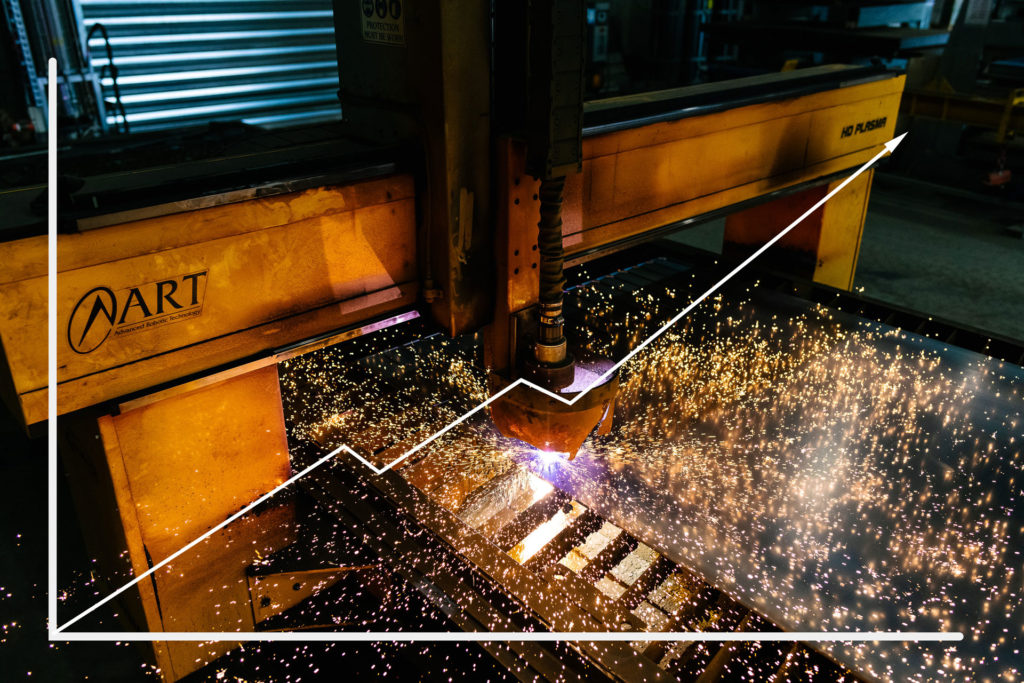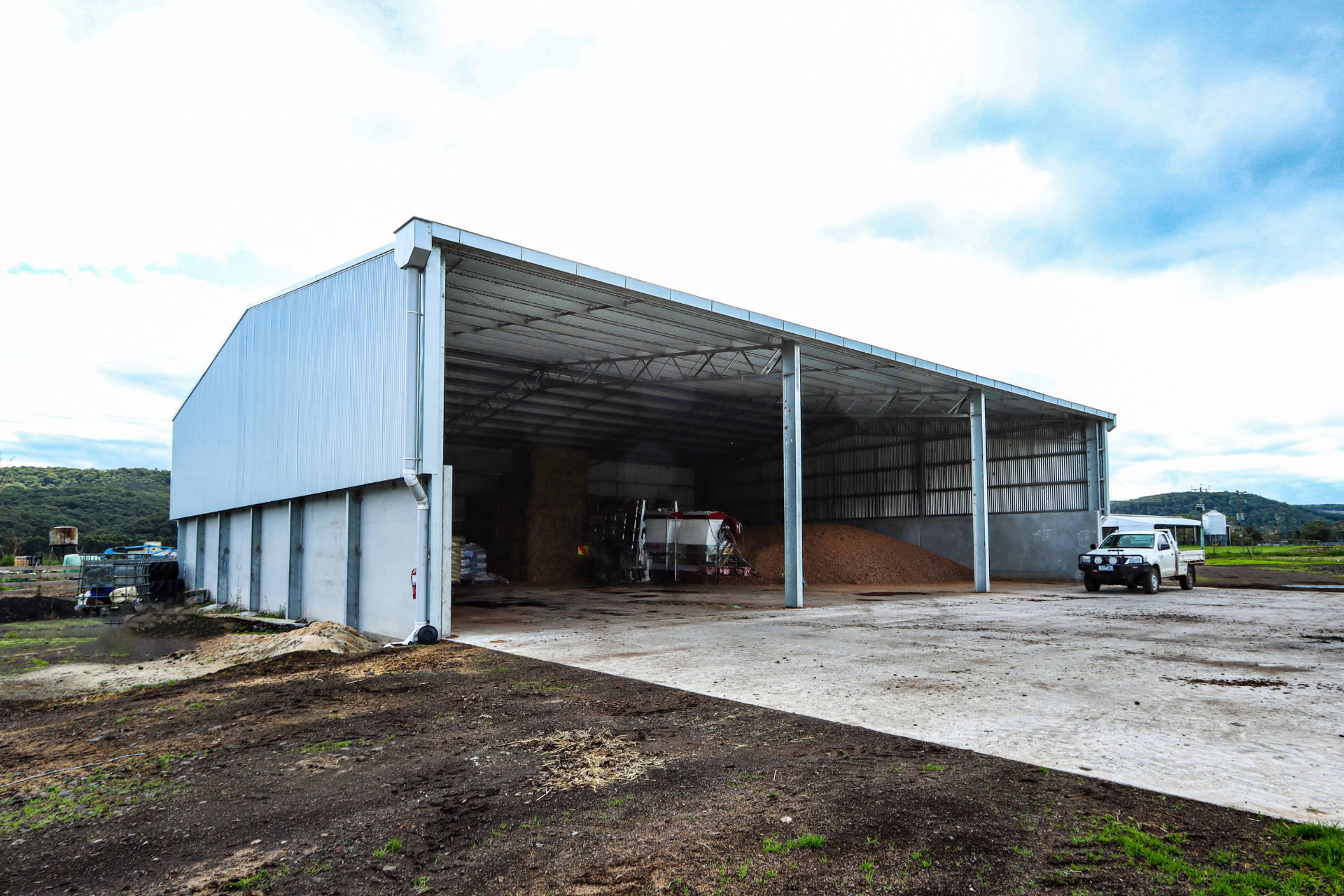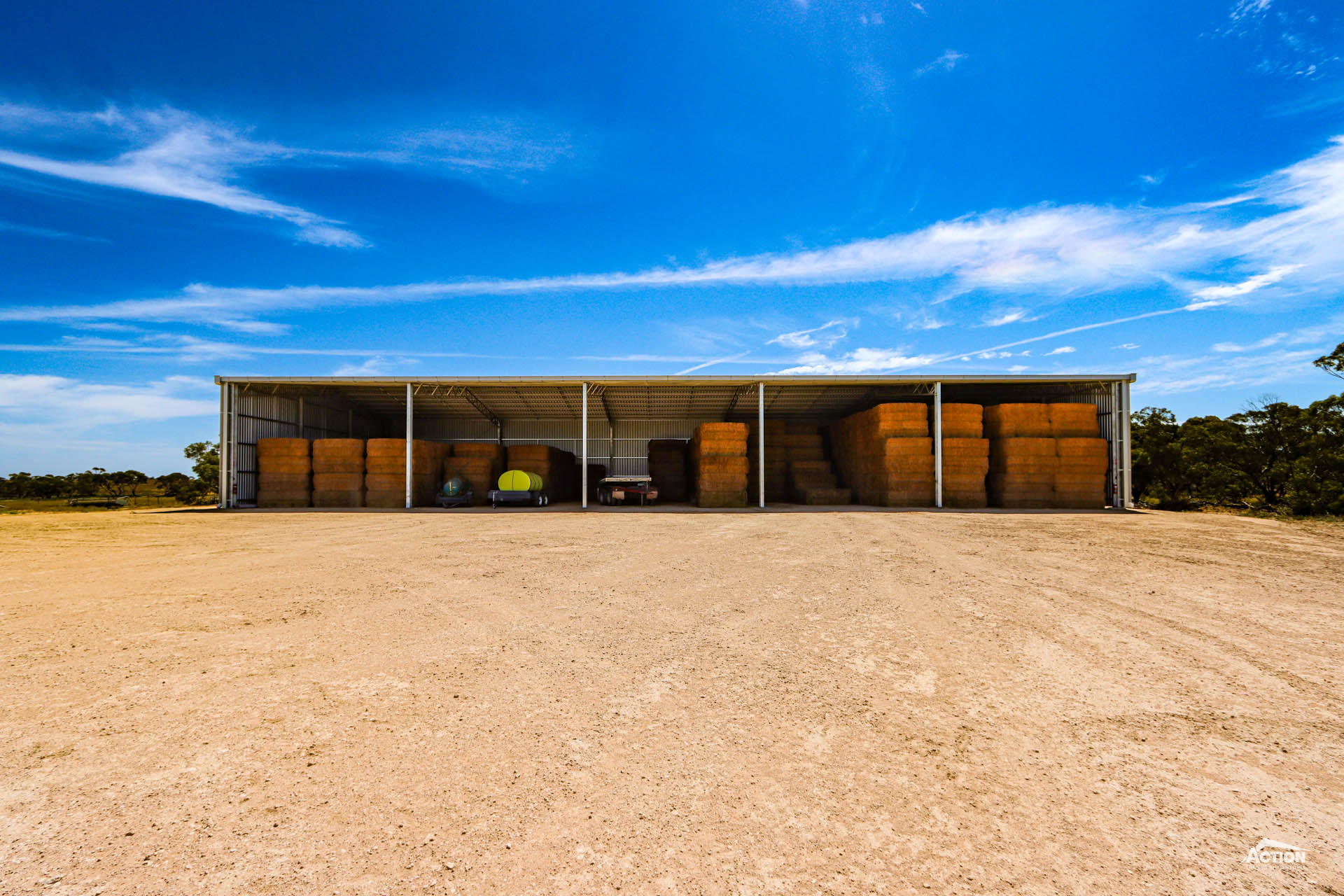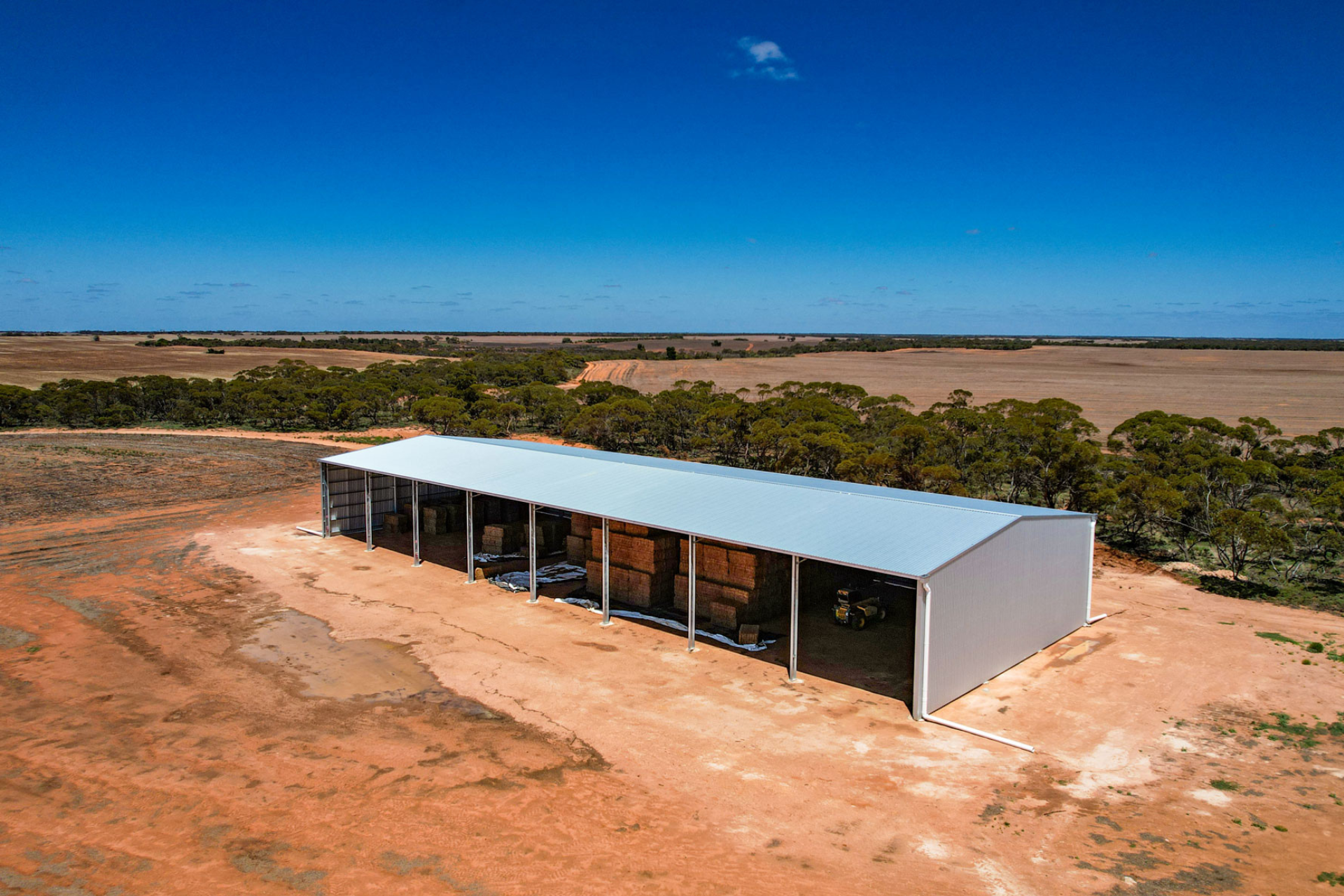Let’s discuss the cost to build a machinery shed!
Storing your farm machinery in a shed makes good economic sense, helping you to get the most out of your machines while simultaneously helping to preserve their resale value.
A farm machinery shed, or workshop shed is a practical investment too, making it easier to keep maintenance up to date; ensuring your machinery is safe to operate and helping to minimise frustrating breakdowns and therefore downtime.
So, there are plenty of good reasons to buy a machinery shed and new machinery shed builds have certainly been popular with more than 100 machinery shed projects currently on the go at Action Steel! But a new machinery shed can be a significant investment, so if you are looking to build a new machinery shed, you probably have a few questions about machinery shed prices.
Some of the most common questions about machinery shed prices include: how can I save money on my machinery shed project? Or how much does it cost to add a canopy? This articles answers many of these frequently asked questions along with: How much does it cost to build a machinery shed?
Keep reading to find the answers to these questions and to learn about the price of popular machinery shed sizes and the key factors that will influence how much your machinery shed costs to build.
Let’s dive right in and start with how much it costs to build a machinery shed.
How does it cost to build a machinery shed?
The average cost of new machinery shed in 2022 has been around $130,000 including GST, footing concrete and erection costs.
As we have mentioned, machinery sheds have been popular this year, so this average cost does cover quite a wide range of machinery shed projects with varying sizes, configurations and design features – so please keep this in mind.
For a more accurate indication of cost and to see how prices vary from project to project, let’s look at some of the most popular machinery shed sizes and configurations and the approximate cost of each.
Popular machinery shed sizes and prices
Here are the price ranges for some of the most popular machinery shed sizes and configurations which include GST, footing concrete and erection.
Please note that these price ranges are approximate and should only be used as a price guide and budgeting tool. For a more accurate price, request an obligation-free quote.
- An open-front 24m x 15m x 5m machinery shed costs approx. $70,000 – $90,000
- A fully enclosed 24m x 15m x 5m machinery shed costs approx. $105,000 – $130,000
- An open-front 32m x 18m x 6m machinery shed costs approx. $95,000 – $120,000
- A drive-through 32m x 18m x 6m machinery shed costs approx. $95,000 – $120,000
- An open-front 40m x 21m x 6m machinery shed costs approx. $135,000 – $165,000
- A drive-through 40m x 21m x 6m machinery shed costs approx. $140,000 – $170,000
- An open-front 48m x 24m x 6m machinery shed costs approx. $175,000 – $210,000
- An open-front 48m x 24m x 6m machinery shed with 6m canopy costs approx. $215,000 – $255,000
Factors that influence machinery shed prices
To understand machinery shed prices and how they can vary from project to project, you need to understand the different factors that influence the cost of a machinery shed build.
Some of the main factors, which we discuss below, are the size of the shed, the configuration of the shed, the design features included in the project and of course, the cost of the materials.

1. Size
The shed size you choose will directly impact the cost of the project, simply because the bigger the shed the more materials and labour that are required.
The other point to keep in mind when it comes to shed size is that a large machinery workshop can be classified differently to a machinery storage shed under the Building Code of Australia. If this is the case, the workshop shed will need to satisfy further requirements such as fire design and including extra access points and amenities, which will be an additional cost to the project.
The next factor is one of the most important – design.
2. Design
The more complex the shed design, the more expensive the project will be. Some common design features for machinery sheds include cantilevered canopies, girder trusses, making allowance for a gantry crane, sliding doors, custom gutter systems and a concrete slab – and all of these will increase the price of a shed.
However, it is worth noting that including some or all of these design features on your machinery shed project can help you get the most out of your shed – so the benefits may outweigh the cost and, in some cases, could save you money in the future. For example, installing a custom gutter system can prevent downpipes being damaged by machinery and allows you to capture rainwater run off (which you can calculate, here).
3. Materials
You can’t build a machinery shed without materials, so obviously the cost of materials is one of the main contributors to machinery shed prices. If the cost of materials go up, so do shed prices and this has been the case with steel.

Our machinery sheds are manufactured from Australian-made steel including heavy-duty UB columns and open web trusses which means that rises and falls in steel prices directly impacts the cost of machinery sheds.
Rest assured we do all we can to minimise the impact of any steel price rises on our sheds. We do this by negotiating with our suppliers and holding higher levels of stock.
This also applies to the cladding for your shed project.
When it comes to cladding, we offer two options: zinc cladding and Colorbond cladding.
Zinc is the less expensive cladding option and is used for the majority of farm shed builds including farm machinery sheds. You may want to consider using Colorbond cladding if you live near the coast though, for additional corrosion protection, which leads us to the other material cost to keep in mind – the cost of hot-dip galvanising.
Hot-dip galvanising is the most effective way to protect steel from rust, but it is also generally the most expensive way. Every Action Steel shed is fully hot dip galvanised after manufacture (both columns and trusses) which means you can expect to pay more for an Action Steel machinery shed than a painted or pre-galv alternative. We don’t recommend compromising on corrosion protection though, and you can read why in these articles: Why should you avoid a shed with painted columns? And What is the difference between hot dip galvanising and pre-galv?
4. Configuration
The shed configuration also influences the price of a project. How? Here are some of the ways shed configuration affects price.
Generally, a long shed will cost less to build that a wide shed – which is why a drive-through shed can be the most cost-effective way to store long machinery.
A fully enclosed shed is also more expensive than an open-front shed, simply because of the extra cladding and sliding doors required.
So, that’s a brief overview of how these factors can influence the cost to build a machinery shed. Some other factors that will come into play will be the location of your shed (this will determine delivery costs) and the orientation of your shed (some orientations will require heavier engineering, increasing the cost of the shed.)
Next up we discuss some cost-effective design suggestions for machinery sheds that may help you save money on your project, please keep in mind though that it is important that your machinery shed design works for you. Don’t sacrifice a good design for the sake of a few dollars!
How can I save money on my farm machinery shed project?
Some of the potential cost-savings on a machinery shed include choosing a ‘standard’ size and opting for a cost-effective configuration. Keep reading to learn about each of the different ways you can save money on a machinery shed.
1. Choose a standard size span
We recommend that you choose a span from our standard size range. Choosing one of these spans is a cost-saving because it means a new truss jig does not have to be set up specifically for your project.
Our standard spans include a range of practical sizes suited to machinery sheds including 18 metres, 21 metres, 24 metres, 27 metres, 30 metres and 36 metres – right through to 60 metres clear span.
2. Choose a cost-effective and versatile configuration
As we have already discussed, some configurations are more cost-effective than others.
The most cost-effective configuration is usually a drive-through configuration as it is the least expensive option for wide access and is also the cheapest way to store long machinery. So, choosing a drive-through configuration, where practical, may be a way that you can cut costs on your machinery shed project without compromising on quality.
It is also a good idea to pay attention to the versatility of a configuration when looking for ways to save money on your machinery shed project, particularly as a machinery shed can be multi-use.
For example, you may want to consider combining your machinery storage shed with a workshop shed, rather than building two standalone sheds. One way to do this is to build an open-front machinery storage shed and dedicate one or two lock-up bays for machinery maintenance. Another way is to build a fully enclosed machinery shed with a dedicated workshop area with a concrete slab to one side.
Similarly, if you opt for an open-front machinery shed design, it means that the shed could potentially also be used for fodder storage such as hay or grain in the future.
3. Install a canopy
Installing a canopy on your machinery shed is a cost-effective way to get more machinery under cover, especially when compared to making the overall shed deeper.
For example, it will be more cost-effective to build a 24-metre span shed with a 6-metre canopy (providing 30m shed depth) rather than building a 30-metre span shed. This is often useful to cover longer machinery such as air seeders, augers and b-doubles etc.
4. Consider your lighting options
While skylights may not suit every shed project, installing skylights in your machinery shed could allow you to take advantage of the available natural light and reduce your power bill!
Or if you are building an open-front machinery shed, choose the right orientation so that the shed remains well-lit during the day.
5. Build for the future
Another way to save money on your machinery shed project is to build for the future. If your budget it tight right now, provision can be made for the shed to be clad later on or for extra bays added in the future.
We hope these five cost-saving suggestions help you with your machinery shed project budget. Our building consultants are always happy to quote as many different options as you need to help you find what shed size, configuration and design will work best for you, your storage requirements and your budget.
Frequently asked questions
When it comes to machinery shed prices, we are also regularly asked about canopies, girder trusses, sliding doors and concrete slabs. Keep reading to learn more about these and how much they cost.
Should I install a canopy? How much does a canopy cost?
If you are weighing up whether to include a canopy on your machinery shed, it is a good idea to have a look at the benefits of a canopy. For example, a canopy not only provides extra protection for the machinery stored in the shed, but it also provides shelter during unloading and loading. Another advantage is that long machinery can be easily parked undercover.
The cost of adding a canopy on your shed does depends on size but generally you can expect to pay between $100 and $150 per square metre.
How much does a girder truss cost?
A girder truss can add up to between $15,000 and $30,000 to your machinery shed project.
If wide access is a requirement for your machinery shed, a more cost-effective way to achieve this is to opt for wider bays or a drive-through configuration as both of these options require less labour and materials.
How much do sliding doors cost?
If your new machinery shed build requires sliding doors, you are probably wondering how much they will increase the price of your project.
While the cost does depend on the size of the sliding door, a sliding door can cost between $7,000 and $12,000.
What thickness does the concrete slab need to be? How much does a concrete slab cost?
In the video below, Lester talks about concrete slab thicknesses and prices.
We hope this price guide has given you an idea of how much it costs to build a machinery shed. For more articles like this browse our Learning Hub which also includes the latest Action Steel videos and brochures.
Or if you have more questions about machinery shed prices and would like an accurate quote, send us a message or give us a call – we’d be happy to help!







